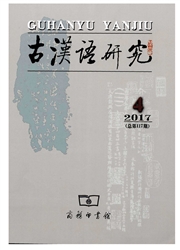

 中文摘要:
中文摘要:
描述斯瓦迪士100核心词的head条在汉语中的历时演变与共时分布,内容包括古今几个主导词的音、形、义、词性、组合关系和本语义场的聚合关系、历时演变、方言差异,最后是小结。表示head义,汉语史上曾经发生过“元→首”和“首→头”两次替换,前者在上古早期就已完成,后者则大概在西汉后期。现代方言主要有“头”系和“脑”系。大约半数以上的方言点说“头”,覆盖了十大方言区。“脑”系中分布最广的是“脑壳”和“脑袋(瓜/瓜子)”,其次是“脑”。各地未见有单称“首”的,作为构词语素残存在双音词中的也罕见,这代表了汉语核心词历时演变的一种类型,即旧词被新词彻底替换,而且基本上是一对一的替换。“头”替换“首”可能是缘于同音竞争。“脑”虽然在西汉就可以指“头”,但是“脑”系的兴起应该比较晚,许多复音形式都是金元时期以后才出现的,不过现在似有逐步取代“头”的趋势。
 英文摘要:
英文摘要:
This paper aims to give a description of the diachronic development and synchronic distribution of tóu and shǒu(viz."head"in the Swadesh lists)in Chinese.The description mainly deals with the sounds,forms,meanings and parts of speech of a couple of corresponding core items and their syntagmatic features,as well as paradigmatic relations,historical development and dialectal distributions of the members of related semantic field,followed by a brief summary.It is argued that,for the meaning of"head",two replacements has taken place in the history of Chinese:yuán“(元”)by shǒu“(首”)and,in turn,shǒu by tóu“(头”).The former replacement was completed by the early Old Chinese period,while the latter one around late West Han Dynasty.In modern Chinese dialects,there are mainly two groups of items centering around tóu and nǎo“(脑”)for the meaning of"head".It is found out that among about over a half dialectal points,tóu is used,covering the ten dialectal areas.Of the group centering around nǎo,nǎo ké“(脑壳”)and nǎo dài(guā/guāzi)“(脑袋”(瓜/瓜子))are most widely used,then followed by nǎo.However,the single item shǒu is not found in use in all the areas,and is even rarely used in disyllabic items as a morphological remnant.Such a change is identified as representing one of the typical patterns of the historical development of Chinese basic vocabulary items,i.e.,old items are completely replaced by new ones,practically in a one-to-one way.It is the author's proposal that the replacement of shǒu by tóu is probably motivated by homonymic competition,and the rise of the nǎo-based group is relatively late,even though nǎo already meant"head"asearly as West Han Dynasty.It is argued that although many multi-syllabic items of the group come into use since the Jin-Yuan Dynasties,there is a tendency that they are gradually replacing tóu.
 同期刊论文项目
同期刊论文项目
 同项目期刊论文
同项目期刊论文
 期刊信息
期刊信息
